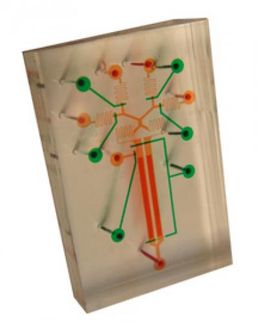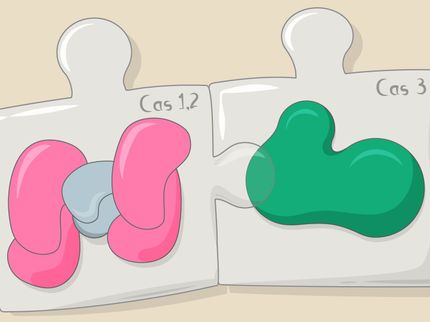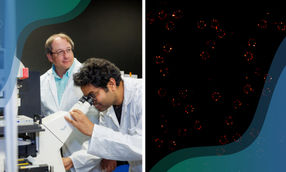Damaged but not defeated: Bacteria use nano-spearguns to retaliate against attacks
New insights into bacterial defense mechanisms
Some bacteria deploy tiny spearguns to retaliate against rival attacks. Researchers at the University of Basel mimicked attacks by poking bacteria with an ultra-sharp tip. Using this approach, they have uncovered that bacteria assemble their nanoweapons in response to cell envelope damage and rapidly strike back with high precision.

Pseudomonas bacteria deploy their nano-spearguns when damaged by a sharp tip (15,000 x magnification).
University of Basel, Biozentrum/SNI Nano Imaging Lab
In the world of microbes, peaceful coexistence goes hand in hand with fierce competition for nutrients and space. Certain bacteria outcompete rivals and fend off attackers by injecting them with a lethal cocktail using tiny, nano-sized spearguns, known as type VI secretion systems (T6SS).
Bacteria respond to cell envelope damage
The research group led by Professor Marek Basler at the Biozentrum, University of Basel, has been studying the T6SS of different bacterial species for many years. “We knew that Pseudomonas aeruginosa uses its T6SS to fire back when attacked”, explains Basler. “But we did not know what exactly triggers the assembly of the nano-speargun: the contact with neighbors, toxic molecules, or simply cell damage?”
In close collaboration with Roderick Lim, Argovia Professor for Nanobiology at the Biozentrum and the Swiss Nanoscience Institute (SNI), the researchers have now demonstrated: Pseudomonas aeruginosa responds to ruptures in the outer membrane – initiated by mechanical force, such as poking with a sharp tip. The study has been published in Science Advances.
Puncturing bacterial envelope with a tiny “needle”
Roderick Lim’s lab has a long-standing expertise in atomic force microscopy (AFM) technology. “Using AFM, we have been able to mimic a bacterial T6SS attack”, says Mitchell Brüderlin, PhD student at the SNI PhD School and first-author of the study. “With the needle-like, ultra-sharp AFM tip, we can touch the bacterial surface and, with gradually increasing the pressure, puncture the outer and the inner membrane in a controlled manner.”
In combination with fluorescence microscopy, the researchers revealed that the bacteria respond to outer membrane damage. “Within ten seconds the bacteria assemble their T6SS, often repeatedly, at the site of damage and fire back with pinpoint accuracy,” adds Basler. “Our work clearly shows that breaking the outer membrane is necessary and sufficient to trigger T6SS assembly.”
New insights into bacterial defense mechanisms
The biggest challenge for the researchers was the size and the shape of the bacteria. “So far, we have only used the AFM to study eukaryotic cells, including human cells,” explains Lim. “But Pseudomonas bacteria are more than ten times smaller than human cells, so it was demanding to poke them at a specific site.”
In the microbial ecosystem, survival is all about strategy, and Pseudomonas aeruginosa has certainly mastered the art of defense. “The targeted and swift retaliation against local attacks minimizes misfiring and optimizes the cost-benefit ratio”, says Basler. This clever tactic gives Pseudomonas a survival advantage, enabling it to incapacitate attackers and thrive in diverse and often challenging environments.
Original publication
Other news from the department science

Get the life science industry in your inbox
By submitting this form you agree that LUMITOS AG will send you the newsletter(s) selected above by email. Your data will not be passed on to third parties. Your data will be stored and processed in accordance with our data protection regulations. LUMITOS may contact you by email for the purpose of advertising or market and opinion surveys. You can revoke your consent at any time without giving reasons to LUMITOS AG, Ernst-Augustin-Str. 2, 12489 Berlin, Germany or by e-mail at revoke@lumitos.com with effect for the future. In addition, each email contains a link to unsubscribe from the corresponding newsletter.
Most read news
More news from our other portals
Last viewed contents
Circumflex_scapular_artery
Streptococcus_pneumoniae
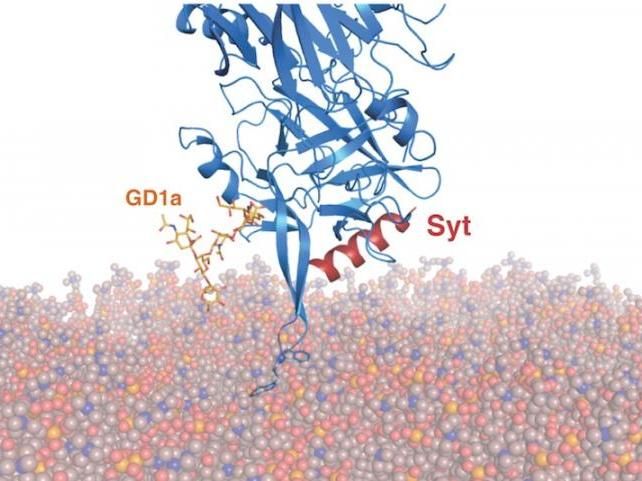
Building a better botox - Small engineering tweaks to botulinum toxin B could make it more effective and longer-lasting with fewer side effects

Optimizing Kinetics Assays to Prevent Avidity Effects - Robust experimental design avoids artefacts in the measurement of binding kinetics and affinity
Alpha-Ethyltryptamine
Olink Genomics expands: New location and recruitment of CTO
People with MS-related memory and attention problems have signs of extensive brain damage
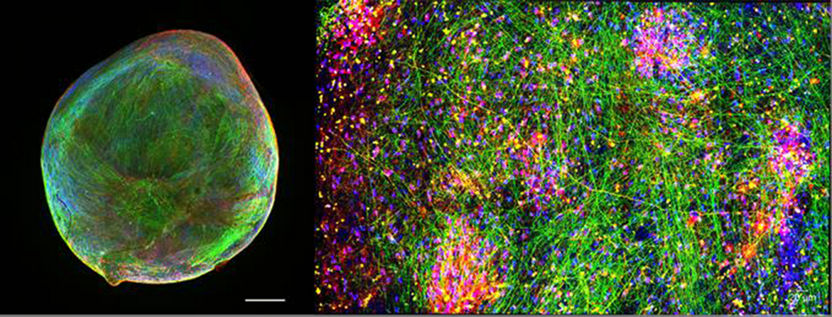
Generation of human brain organoids with the ability to learn - Bioengineered Neuronal Organoids recapitulate important morphological features of the human brain
Carpus

